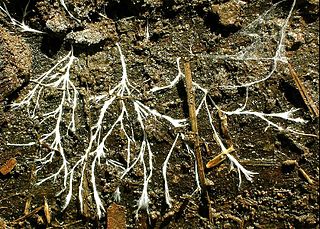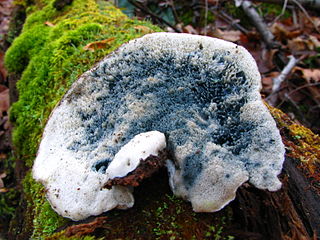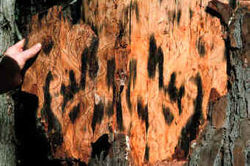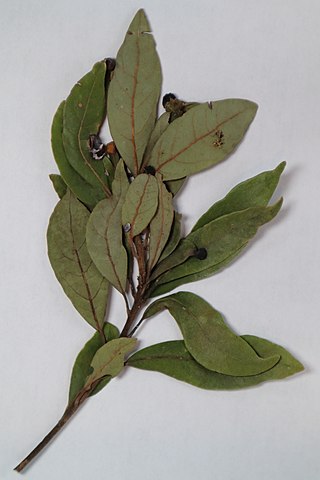
Phytophthora cinnamomi, also known as cinnamon fungus, is a soil-borne water mould that produces an infection which causes a condition in plants variously called "dieback", "root rot", or, "ink disease".

Xerocomus is a genus of poroid fungi related to Boletus. Many mycologists did not originally recognize the distinction between the two genera and placed Xerocomus taxa in genus Boletus. However, several molecular phylogenetic studies have demonstrated that Xerocomus is a heterogeneous genus of polyphyletic origin, which has resulted in further division of Xerocomus into Xerocomellus and Hemileccinum. The members of the genus Xerocomellus are more closely related to Boletus than true Xerocomus is, which is relatively distantly related to Boletus and more closely related to Phylloporus. Other former Xerocomus species have since been moved to Aureoboletus, Imleria, Hortiboletus and Rheubarbariboletus.

Mycelial cords are linear aggregations of parallel-oriented hyphae. The mature cords are composed of wide, empty vessel hyphae surrounded by narrower sheathing hyphae. Cords may look similar to plant roots, and also frequently have similar functions; hence they are also called rhizomorphs. As well as growing underground or on the surface of trees and other plants, some fungi make mycelial cords which hang in the air from vegetation.

Armillaria luteobubalina, commonly known as the Australian honey fungus, is a species of mushroom in the family Physalacriaceae. Widely distributed in southern Australia, the fungus is responsible for a disease known as Armillaria root rot, a primary cause of Eucalyptus tree death and forest dieback. It is the most pathogenic and widespread of the six Armillaria species found in Australia. The fungus has also been collected in Argentina and Chile. Fruit bodies have cream- to tan-coloured caps that grow up to 10 cm (4 in) in diameter and stems that measure up to 20 cm (8 in) long by 1.5 cm (1 in) thick. The fruit bodies, which appear at the base of infected trees and other woody plants in autumn (March–April), are edible, but require cooking to remove the bitter taste. The fungus is dispersed through spores produced on gills on the underside of the caps, and also by growing vegetatively through the root systems of host trees. The ability of the fungus to spread vegetatively is facilitated by an aerating system that allows it to efficiently diffuse oxygen through rhizomorphs—rootlike structures made of dense masses of hyphae.

Roystonea regia, commonly known as the royal palm, Cuban royal palm, or Florida royal palm, is a species of palm native to Mexico, the Caribbean, Florida, and parts of Central America. A large and attractive palm, it has been planted throughout the tropics and subtropics as an ornamental tree. Although it is sometimes called R. elata, the conserved name R. regia is now the correct name for the species. The royal palm reaches heights from 15–24 m (50–80 ft) tall. Populations in Cuba and Florida were long seen as separate species, but are now considered a single species.

Pisolithus is a genus of fungi within the family Sclerodermataceae.

Oligoporus is a genus of fungi in the family Polyporaceae. The genus was circumscribed by German mycologist Julius Oscar Brefeld in 1888 with Oligoporus farinosus as the type. This species is currently known as Postia rennyi. The genus name combines the Ancient Greek words ὀλίγος ("few") and πόρος ("pore").

Ophiostoma is a genus of fungi within the family Ophiostomataceae. It was circumscribed in 1919 by mycologists Hans Sydow and Paul Sydow.

Deconica coprophila, commonly known as the dung-loving psilocybe, meadow muffin mushroom, or dung demon, is a species of mushroom in the family Strophariaceae. First described as Agaricus coprophilus by Jean Baptiste François Pierre Bulliard in 1793, it was transferred to the genus Psilocybe by Paul Kummer in 1871. In the first decade of the 2000s, several molecular studies showed that the Psilocybe was polyphyletic, and the non-bluing (non-hallucinogenic) species were transferred to Deconica.

Sistotrema is a genus of fungi in the family Hydnaceae. The genus contains at least 55 species and has a worldwide distribution. The type species is Sistotrema confluens Pers. (1794).

Ceratocystis is a genus of fungi in the family Ceratocystidaceae. Several species are important plant pathogens, causing diseases such as oak wilt and pineapple black rot.

The Ceratocystidaceae are a family of fungi in the class Sordariomycetes, subclass Hypocreomycetidae.
Ambrosiella is a genus of ambrosia fungi within the family Ceratocystidaceae. It was circumscribed by mycologists Josef Adolph von Arx and Grégoire L. Hennebert in 1965 with Ambrosiella xylebori designated as the type species. All Ambrosiella species are obligate symbionts of ambrosia beetles. Several former species were moved to genera Raffaelea, Hyalorhinocladiella, or Phialophoropsis, and there were nine species recognized 2017. Twelve species in as of 2023. One species, Ambrosiella cleistominuta, has been observed to produce a fertile sexual state with cleistothecious ascomata.
Endoconidiophora is a genus of fungi within the Ceratocystidaceae family.

The Magnaporthaceae are a family of fungi in the order Magnaporthales. It was circumscribed by Paul F. Cannon in 1994 for a group of grass-associated fungi centered on Magnaporthe (Nakataea). Magnaporthaceae have a harpophora-like asexual morphology and are often associated with roots of grasses or cereals.
Gabarnaudia is a genus of anamorphic fungi that was placed in the family Ceratocystidaceae, until phylogenetic analysis by Hausner and Reid (2004) and De Beer et al. (2013a) showed that Gabarnaudia fimicolaG. betae and G. humicola clustered within genus Sphaeronaemella.

Picipes badius, commonly known as the black-footed polypore or black-leg, is a species of fungus in the family Polyporaceae. It causes a white rot of hardwoods and conifers. The species is found in temperate areas of Asia, Australia, Europe, and North America. It has a dark brown or reddish-brown cap that reaches a diameter of 25 cm (9.8 in), and a stipe that is often completely black or brown at the top and black at the base.

The Coniochaeta are a genus of pleomorphic yeasts of the order Coniochaetales and are pathogens of trees. Some species have also been found to form endophytic associations within plants in which they live inside plant tissues but do not actually harm the organism. They can take the form of pink to brown colonies, hyphae, conidiophores or sclerotia. In 2013, the Lecythophora were merged with the Coniochaeta, following suggestions by Ziauddin Khan et al.

Raffaelea is a genus of ambrosia fungi in the family Ophiostomataceae. It was circumscribed by mycologists Josef Adolph von Arx and Grégoire L. Hennebert in 1965 with Raffaelea ambrosiae as the type species. The genus is named in honor of Italian botanist Raffaele Ciferri.
Ambrosiella roeperi is the fungal symbiont of the granulate ambrosia beetle, Xylosandrus crassiusculus, facilitating this insect’s capacity to accumulate on and damage a diverse array of woody plants from around the world. It is one of several important nutritional partners derived from order Microascales that sustain and are transported by xylomycetophagous scolytine beetles.
















